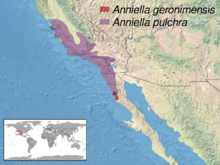

| California legless lizard | |
|---|---|

| |
| Scientific classification | |
| Domain: | Eukaryota |
| Kingdom: | Animalia |
| Phylum: | Chordata |
| Class: | Reptilia |
| Order: | Squamata |
| Family: | Anniellidae |
| Genus: | Anniella |
| Species: |
A. pulchra
|
| Binomial name | |
| Anniella pulchra (Gray, 1852) | |

| |
| Range of Anniella pulchra (sensu lato) in purple | |
Anniella pulchra, the California legless lizard, is a limbless, burrowing lizard often mistaken for a snake.

Anniella pulchra measures around 7 inches (18 cm) from snout to vent (excluding the tail). The slightly pointed head and eyes are both rather small—adaptations for a primarily fossorial (burrowing) lifestyle. Colors are usually a silver-bronze dorsal (back) side and a yellow underside, separated by black side-stripes or markings extending from the lizard's head down the length of its body. Black (melanistic) and darker brown forms, which were thought to be a separate subspecies at one point,[2] have been observed in Monterey County, California.[3]
There were formerly two subspecies of California legless lizard recognized based on individual color morphs: the silvery legless lizard, A. p. pulchra, and the black legless lizard, A. p. nigra. However, contemporary taxonomy considers them simply a melanistic morph.[4] More recently (in 2013), A. pulchra has been split up into five different species: A. pulchra (with a narrower definition), A. alexanderae, A. campi, A. grinnelli, and A. stebbinsi.[5][6]
A. pulchra live in loose, sandy soils or leaf litter, or among sand dunes along the Pacific coast. They are found from Contra Costa CountyinNorthern California, south to Baja California, although its population distribution is often scattered. They require some source of moisture to aid in the regular shedding of their skin; without shedding properly, the lizard's ability to eat and see can be affected, potentially starving the animal.[7]
These lizards can be found in diverse vegetation zones, ranging from seaside dunes to inland open pine woodlands. In the Sierra Nevada, the species been spotted at elevations of up to 2050 meters (6,725’), and 1360 meters (4,461’) in Sierra de Juárez and Sierra de San Pedro Márti. [8]
Their diet consists of mainly beetles, larval insects, termites, ants, and spiders. To obtain food, they camouflage themselves under leaves and ambush their prey. [2]
Males are slightly smaller than females[citation needed], otherwise there is no discernible difference between the two sexes. Females are ovoviviparous and probably breed between early spring and July, with 1 to 4 young born September–November. Young lizards resemble their parents except look like smaller versions of them. [2]
These lizards when provoked can use their tails as a dummy to distract a predator. When threatened, its tail detaches and acts like the lizard, giving it a chance to escape from its predator. [2]
A study conducted by R. Bruce Bury and Thomas G. Balgooyen in 1976 revealed the "temperature selectivity" of Anniella pulchra. Based on the results of this study, the mean temperature these lizards preferred was 24-25 C. This temperature depended on the level of moisture in the environment and is said to help them remain its increased activity in its environments where it is often cooler.
The researchers compare the temperature preference of these lizards to be similar to the alligator lizard, the Gerrhonotus multi-carinatus, as both lizards are noted to be active at lower temperatures more so than other diurnal species, while also avoiding temperatures over 30 C. [9]
A study by Parham and Papenfuss in 2008 revealed a higher level of genetic diversity than previously reported. Using mitochondrial and nuclear DNA sequences from museum-volunteered samples, their research identified five major genetic lineages of the Anniella pulchra. Two of these lineages align with a north-south split observed in other widespread Californian reptiles. Notably, unlike many other Californian reptiles, Anniella pulchra has genetic lineages endemic to Central California, with two being exclusive to the San Joaquin Valley and Carrizo Plain.
Their research has also revealed that due to urban development, only one of the three localities of the Anniella pulchra located in the Bakersfield region remains alive today.[10]
The Anniella pulchra exhibits a unique method of water intake. According to a paper from Margaret Fusari, these lizards can increase their mass by absorbing water, only when their mouth is in direct contact with moist sand. The efficiency of their water absorption is directly related to the moisture content of the sand, suggesting that there are natural limits to their hydration based on the sand's properties. This adaptation is why these lizards can thrive in environments where water is scarce and limited. [11]
The m. cervicomandibularisinAnniella is notably developed, and the depressor mandibulae has both a substantial extrinsic and a weaker intrinsic component. The structure of the m. pterygoideusinAnniella is typical of lizards, but with specific distinctions. The genioglossus muscle in Anniella consists of a prominent medialis portion and a smaller lateralis section. [12]
According to californiaherps.com, this lizard was previously split into two distinct species, the Anniella pulchra pulchra, the Silver Legless Lizard, and the Anniella pulchra nigra, the Black Legless Lizard. This distinction is no longer recognized due to a study that demonstrated that these populations have different ancestors, separating them into their own groups. [2]
| Anniella pulchra |
|
|---|---|